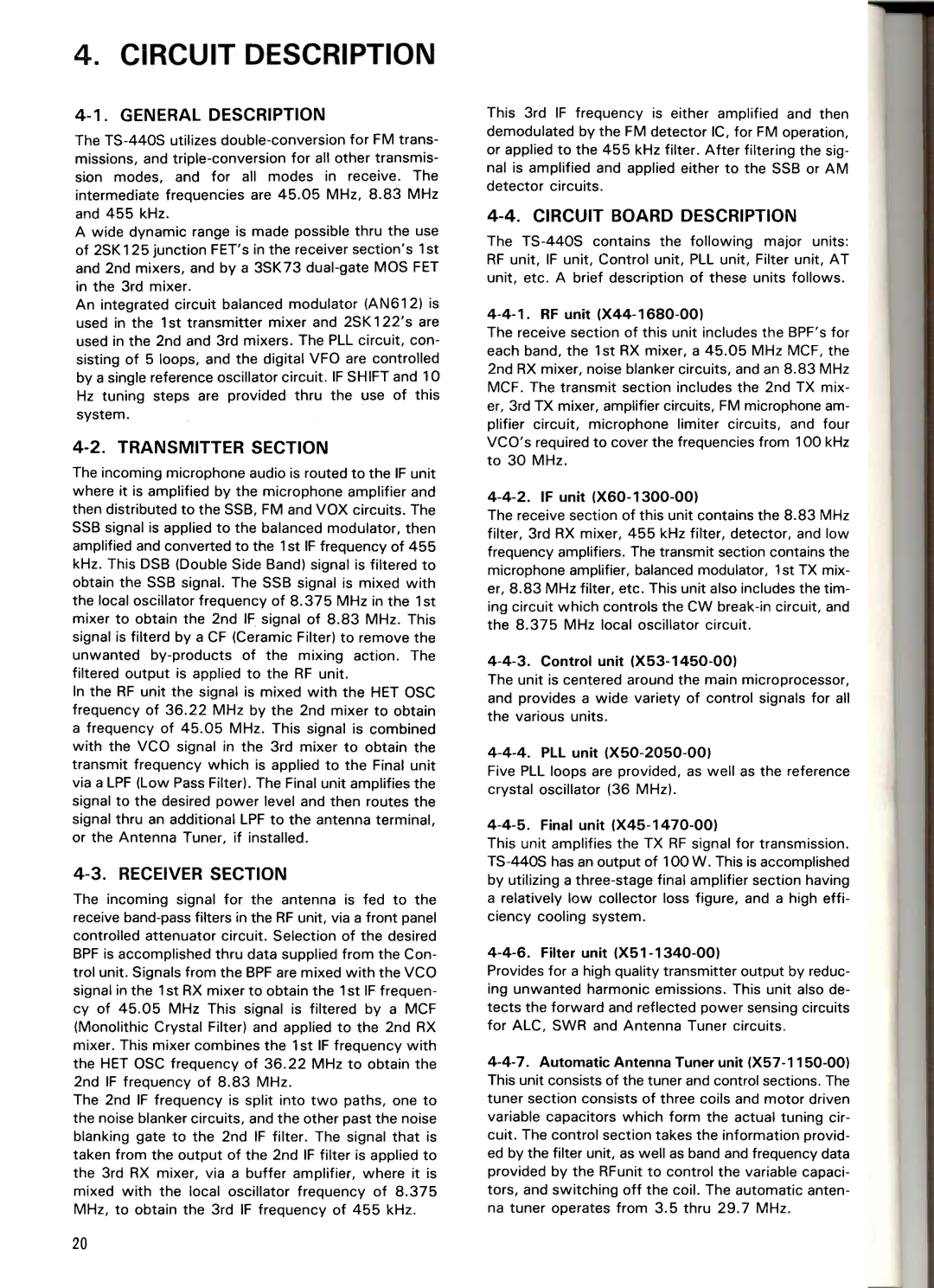
4.
4-1. GENERAL DESCRIPTION
The
missions, and
A wide dynamic range is made possible thru the use of 2SK 125 junction FET's in the receiver section's 1 st and 2nd mixers, and by a 3SK 73
An integrated circuit balanced modulator (AN612) is
used in the 1 st transmitter mixer and 2SK 1 22's are used in the 2nd and 3rd mixers. The PLL circuit, con- sisting of 5 loops, and the digital VFO are controlled by a single reference oscillator circuit. IF SHIFT and 10 Hz tuning steps are provided thru the use of this
system.
4-2. TRANSMITTER SECTION
The incoming microphone audio is routed to the IF unit where it is amplified by the microphone amplifier and then distributed to the SSB, FM and VOX circuits. The SSB signal is applied to the balanced modulator, then amplified and converted to the 1 st IF frequency of 455 kHz. This DSB (Double Side Band) signal is filtered to obtain the SSB signal. The SSB signal is mixed with the local oscillator frequency of 8.375 MHz in the 1st mixer to obtain the 2nd IF signal of 8.83 MHz. This signal is filterd by a CF (Ceramic Filter) to remove the
unwanted
In the RF unit the signal is mixed with the HET OSC frequency of 36.22 MHz by the 2nd mixer to obtain a frequency of 45.05 MHz. This signal is combined with the VCO signal in the 3rd mixer to obtain the transmit frequency which is applied to the Final unit via a LPF (Low Pass Filter). The Final unit amplifies the signal to the desired power level and then routes the signal thru an additional LPF to the antenna terminal, or the Antenna Tuner, if installed.
4-3. RECEIVER SECTION
The incoming signal for the antenna is fed to the receive
BPF is accomplished thru data supplied from the Con- trol unit. Signals from the BPF are mixed with the VCO signal in the 1 st RX mixer to obtain the 1 st IF frequen- cy of 45.05 MHz This signal is filtered by a MCF (Monolithic Crystal Filter) and applied to the 2nd RX mixer. This mixer combines the 1 st IF frequency with the HET OSC frequency of 36.22 MHz to obtain the 2nd IF frequency of 8.83 MHz.
The 2nd IF frequency is split into two paths, one to the noise blanker circuits, and the other past the noise blanking gate to the 2nd IF filter. The signal that is taken from the output of the 2nd IF filter is applied to the 3rd RX mixer, via a buffer amplifier, where it is
mixed with the local oscillator frequency of 8.375 MHz, to obtain the 3rd IF frequency of 455 kHz.
This 3rd IF frequency is either amplified and then demodulated by the FM detector IC, for FM operation, or applied to the 455kHz filter. After filtering the sig- nal is amplified and applied either to the SSB or AM detector circuits.
4-4. CIRCUIT BOARD DESCRIPTION
The
The receive section of this unit includes the BPF's for each band, the 1 st RX mixer, a 45.05 MHz MCF, the 2nd RX mixer, noise blanker circuits, and an 8.83 MHz MCF. The transmit section includes the 2nd TX mix- er, 3rd TX mixer, amplifier circuits, FM microphone am-
plifier circuit, microphone limiter circuits, and four VCQ's required to cover the frequencies from 100 kHz to 30 MHz.
4-4-2. IF unit (X60-1300-00)
The receive section of this unit contains the 8.83 MHz filter, 3rd RX mixer, 455 kHz filter, detector, and low frequency amplifiers. The transmit section contains the microphone amplifier, balanced modulator, 1st TX mix- er, 8.83 MHz filter, etc. This unit also includes the tim- ing circuit which controls the CW
4-4-3. Control unit (X53-1450-00)
The unit is centered around the main microprocessor, and provides a wide variety of control signals for all the various units.
Five PLL loops are provided, as well as the reference crystal oscillator (36 MHz).
This unit amplifies the TX RF signal for transmission.
4-4-6. Filter unit IX51-1340-001
Provides for a high quality transmitter output by reduc- ing unwanted harmonic emissions. This unit also de- tects the forward and reflected power sensing circuits for ALC, SWR and Antenna Tuner circuits.
20
